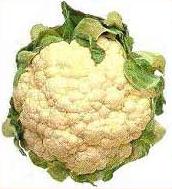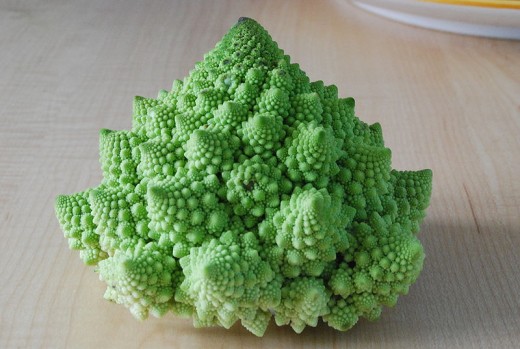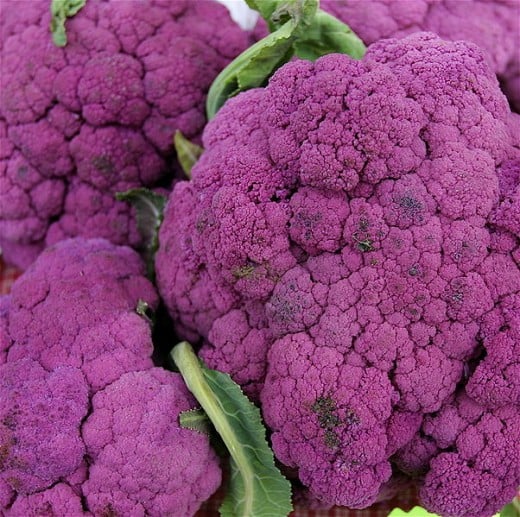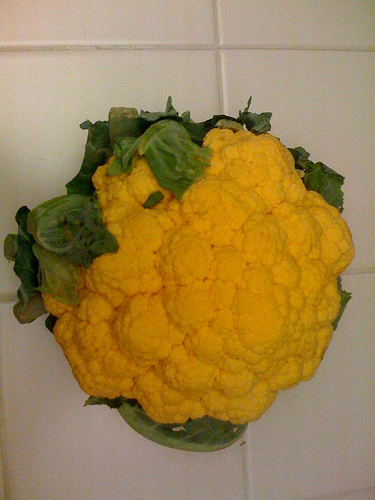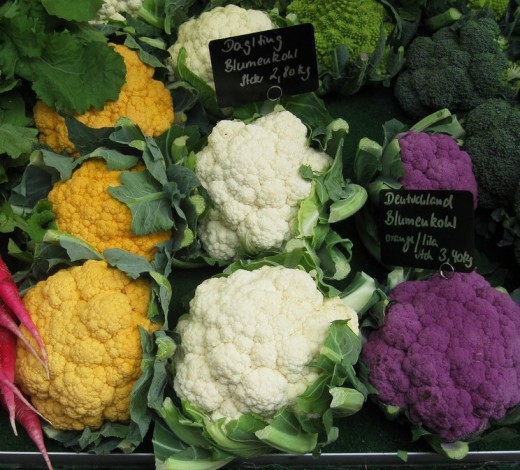What are the Benefits of Cauliflower
Where did Cauliflower Originate
Since Cauliflower and Broccoli are really the same species it originated at the same time in first century Roman times. As such cauliflower (the Latin translation meaning cabbage flower) has been grown and eaten for the last 2,000 years. It's scientific name is Brassica oleracea and it is closely related to broccoli. It was a very popular food plant during the Roman Empire, a
period that began after 15 CE. That popularity has never waned.
Cauliflower, by all rights, is just the flowering part of this cabbage-like plant. The tightly packed buds and the stems those buds grow from are the part of the plant served and consumed in a wide variety of ways.
Unlike broccoli, cauliflower comes in a wide variety of colors, of which white is the most common. Like broccoli cauliflower should not be eaten once the buds open and bloom. Also, unlike broccoli the stems are rarely eaten with most consumers of this food concentrating on the flowering part of the plant only.
Also, cauliflower takes less cook time and is much more delicate than it's close cousin.

Nutritional Value of Cauliflower
Cauliflower is high in vitamin C and A. It also contains calcium, iron, magnesium, phosphorus, potassium, zinc, and trace amounts of selenium.
A three and a half (3.5oz) ounce serving contains almost 5 grams of carbohydrates, 2.5 grams of simple sugar, 2.5 grams of fiber, 0 grams of fat, 2 grams of protein, and less than ten (10%) percent RDA of B1, B2, and B3.
It has been found that as long as cauliflower is not boiled for more than eight minutes it retains most of it's nutrients. Steaming avoids this problem and I highly recommend it.
Some studies suggest that a high intake of broccoli can reduce the risk of prostate, breast cancer and heart disease.
Health Effects of Cauliflower
As with broccoli, cauliflower has high levels of sulforaphane, an anti-cancer compound released when cauliflower is chopped or chewed. It also contains higher than typical levels of the compound indole-3-carbinol. This substance is an anti-estrogen which appears to slow or prevent the growth of tumors of the breast and prostate.
Cauliflower also contains glucosinolates which are linked to improved liver function thereby improving the body's ability to detoxify itself.
Finally, cauliflower makes a great potato substitute (when overcooked and mashed) as it lacks the starches that potatoes typically contain.
Preparing Cauliflower
It might be tempting to cook cauliflower exactly as one cooks broccoli, but this is not so. Cauliflower takes less heat or cooking time and, as with broccoli, I highly recommend steaming, but at reduced amounts of time.
Regardless cauliflower can be boiled, roasted, braised, pan fried, steamed and even eaten raw.
Another difference is that cauliflower, due to it's much more delicate florets, should not be stirred (when boiling) or stirred much less often and much more gently. Excess handling during cooking can cause the florets to break apart and cook at different times.
Growing Cauliflower
Cauliflower does best in cooler climates or early spring. It is not a hot weather crop. The ideal temperature range is 18 to 23 degree Celsius or 64 to 73 °Fahrenheit.
When growing cauliflower, look for a cluster of tiny flower buds in the center of the stalk. Since they haven't flowered yet the buds should be white, purple or green.
It is hard to tell if cauliflower has blossomed as the flowers are the same color as the unopened buds. For that reason you should buy it fresh and consume it shortly after purchase.
Varieties of Cauliflower
Cauliflower comes in white, of course, but there are some other, less common, colors out there. (see photos below)
There is even a form of cauliflower that looks quite strange and has the color of broccoli. By and large all these varieties have the same nutritional profile, with the exception of Orange and Purple Cauliflower.
Orange cauliflower has more twenty-five times the amount of vitamin A as the white variety.
Purple cauliflower has the same nutritional profile as white, but contains the antioxidant group anthocyanin. To date, not studies have been done regarding the benefits of purple cauliflower regarding these anti-oxidants.
Finally the Romanesco broccoli (actually cauliflower) has an otherworldly look and is touted as a rare occurrence (in nature) of fractal image.




Cooking Cauliflower
As stated above my opinion is the that the best way to prepare
broccoli is to steam it. This typically takes no more than five to seven
minutes, gives the vegetable a bright green hue, and insures that the
vitamins and minerals found in broccoli stay within.
Broccoli
can most certainly be boiled, roasted, fried, sauteed, and grilled. With
each cooking method times change slightly. Since it can even be eaten
raw these times are not vitally important unless texture is the primary
consideration.
Cooking times can range anywhere from three minutes, for boiling, to twenty minutes for roasting.
Less Than Usual Cauliflower Recipes
Roasted Cauliflower
You'll need a baking sheet and casserole dish for this one.
Ingredients
- 2 Heads cauliflower
- 1/2 Cup white wine (nothing special here)
- 1/2 Cup chicken broth or water
- 1 Tablespoon extra virgin olive oil
- 1 teaspoon dried oregano
- Kosher salt and freshly ground black pepper
- 6 garlic cloves, sliced thinly
- 1/2 Cup bread crumbs
- 2 Tablespoons chopped fresh Italian parsley
- 1 Cup coarsely shredded Parmesan or pecorino
Directions
- Preheat the oven to 400 degrees F.
- Break apart the cauliflower into large florets and cut off the
thicker stems.
- Set the cauliflower pieces stem side down in a 13 by
9-inch baking dish.
- Pour the wine and broth into the dish and drizzle
olive oil over the cauliflower.
- Sprinkle with the oregano, and salt and
pepper.
- Scatter the garlic slices over everything.
- Cover the pan with
aluminum foil and bake until about 30 minutes.
- The florets should fall apart if you poke them with your finger.
- As this is cooking combine the bread crumbs, chopped parsley, and 1 Tablespoon
olive oil together in a small bowl.
- Once the cauliflower is tender, sprinkle the bread crumb mix and the cheese over the florets and put the dish, uncovered, back in oven until the topping is browned or about 15 minutes.
- Serve immediately.
Cauliflower Soup
Ingredients
- 1 teaspoon canola or other light oil
- 1 teaspoon unsalted butter
- 2 leeks, white parts only, well-washed and chopped
- 1 head cauliflower, broken into florets
- 1 medium all-purpose potato, cubed
- 6 Cups chicken stock
- Freshly ground pepper and pepper
- 1/2 Cup 1 percent low-fat milk (this is optional)
- 4 leaves fresh parsley or cilantro
Directions
- Combine the oil and butter in a large saucepan and warm over
medium-low heat.
- Add the leeks and stirring frequently, allow them cook slowly for 10 minutes. Do not brown.
- Stir in the cauliflower, potatoes, and chicken stock.
- Season with the salt
and pepper then bring to a boil over high heat.
- Once at the boil reduce heat to medium low.
- Cover and simmer for twenty minutes.
- Remove form the heat and allow to cool slightly.
- Transfer to a blender or a food processor fitted with the metal
blade and process until smooth.
- Move liquid from blender to saucepan and place over
medium heat.
- Bring to a simmer for about ten minutes.
- Taste and adjust the seasoning.
- If the soup is too thick, thin with the milk.

